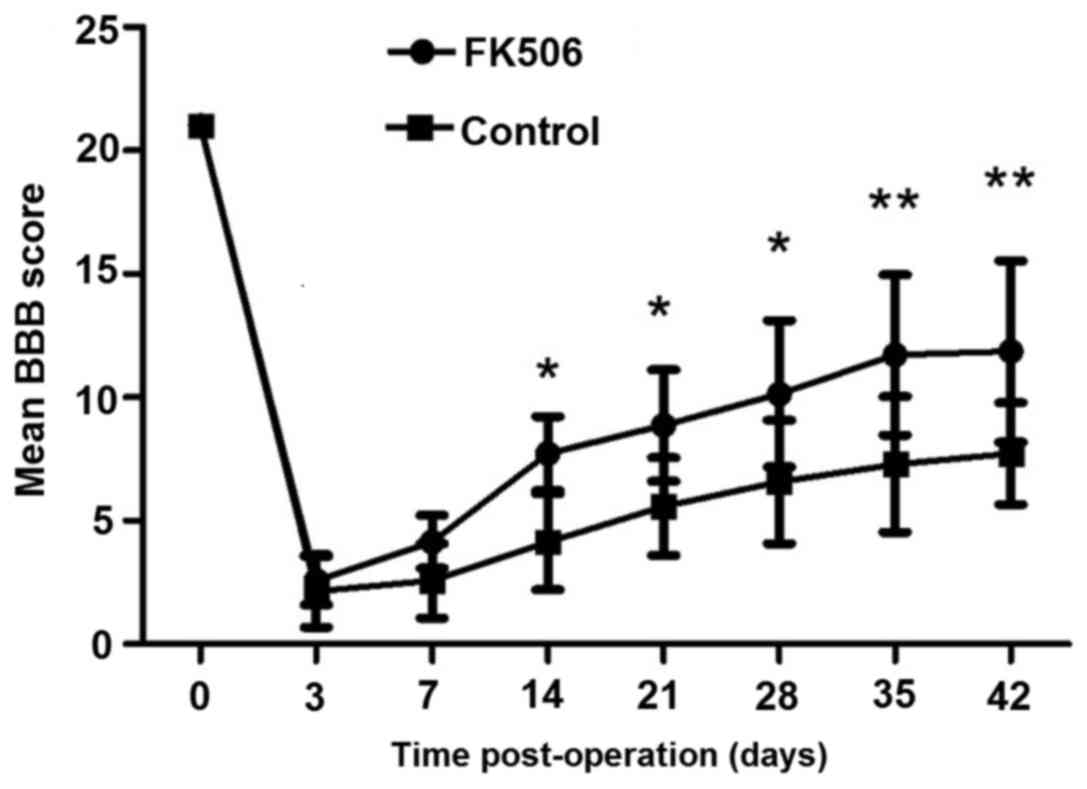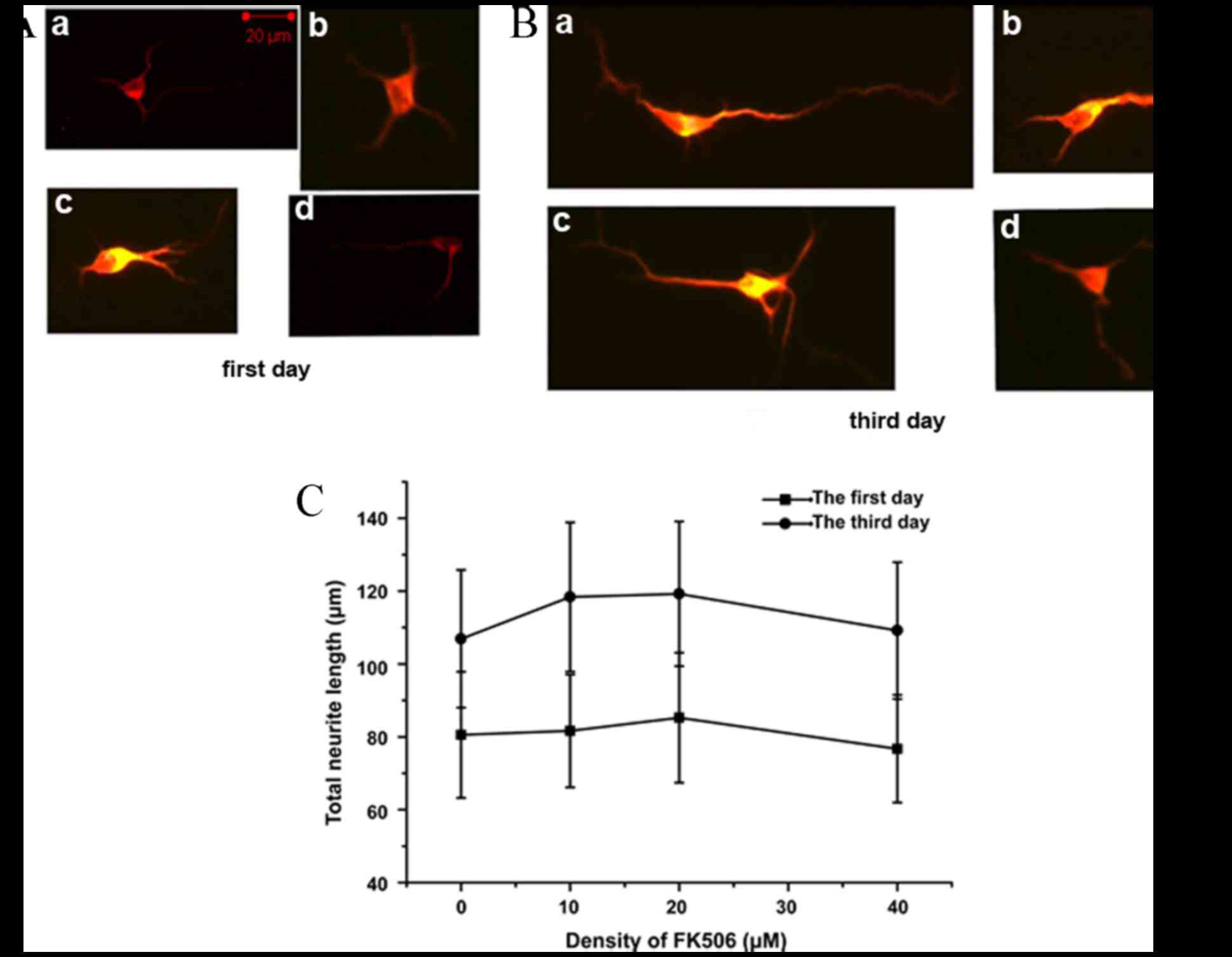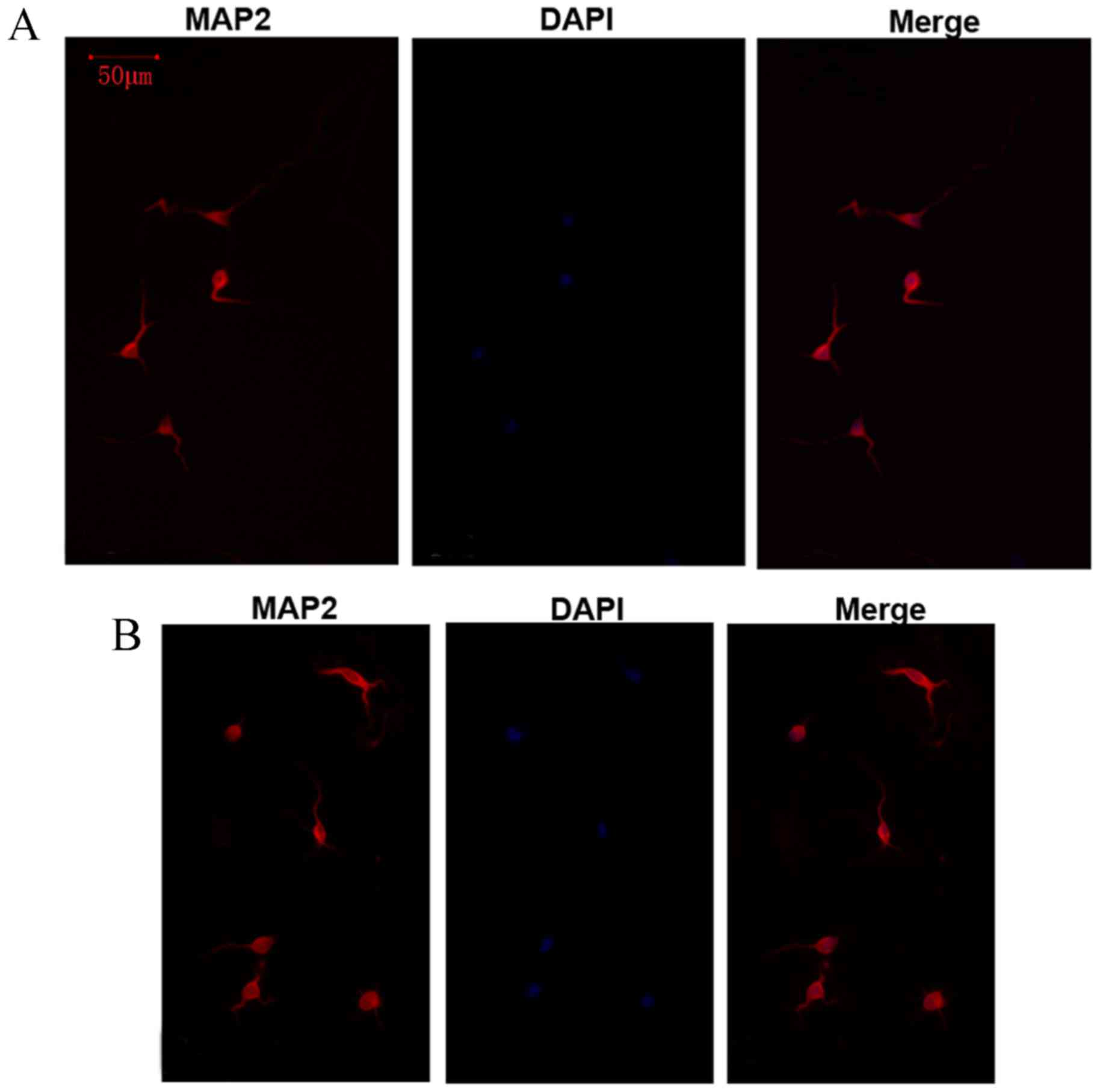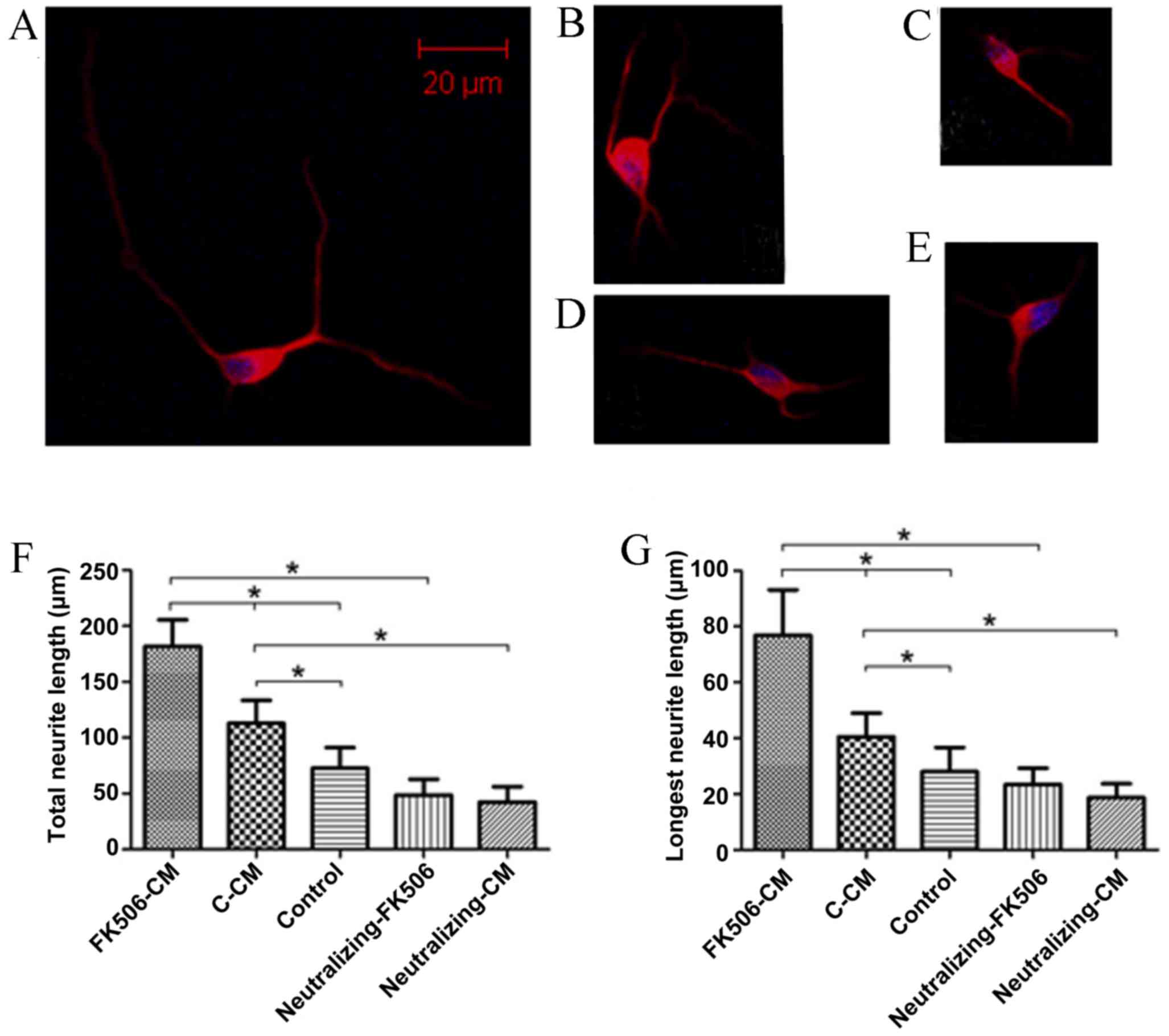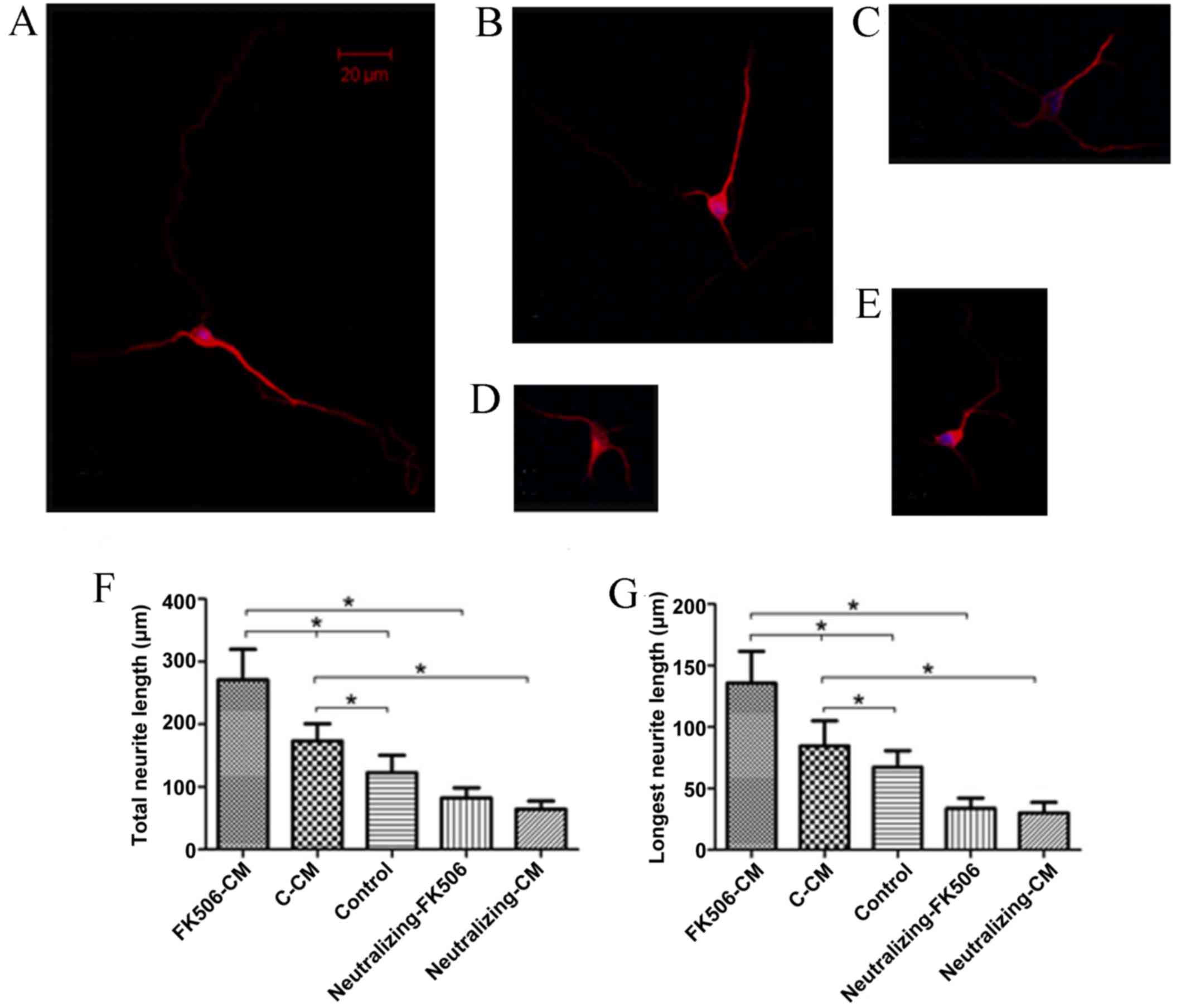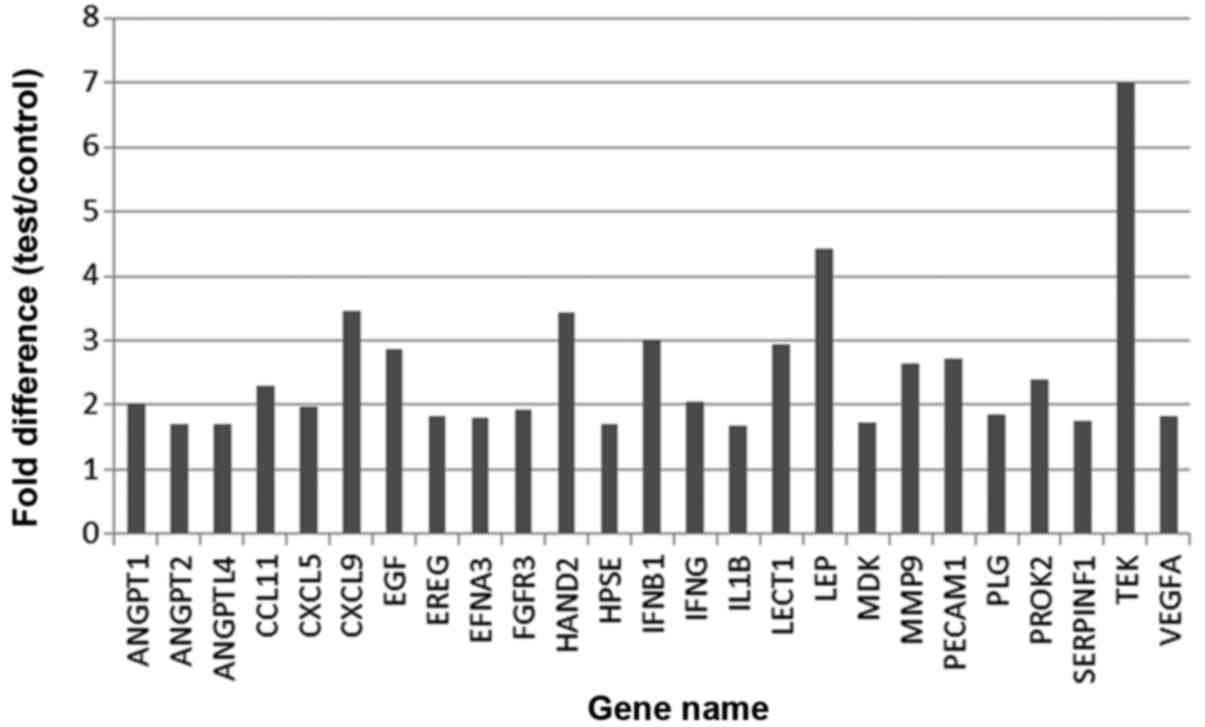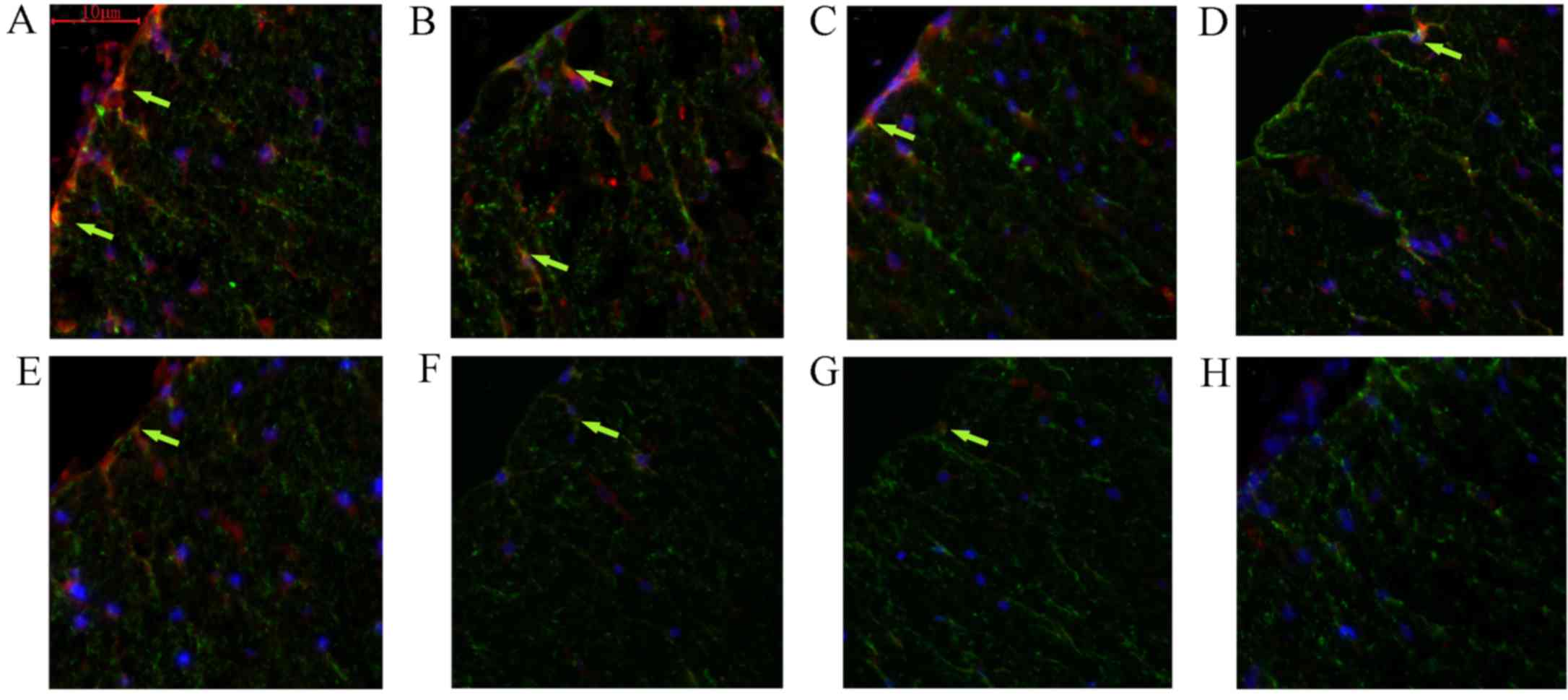Analysis of FK506‑mediated functional recovery and neuroprotection in a rat model of spinal cord injury indicates that EGF is modulated in astrocytes
- Authors:
- Published online on: June 8, 2018 https://doi.org/10.3892/etm.2018.6283
- Pages: 501-510
-
Copyright: © Cai et al. This is an open access article distributed under the terms of Creative Commons Attribution License.
Abstract
Introduction
Spinal cord injury (SCI) is a traumatic event, often resulting in permanent motor and sensory deficits such as paraplegia and tetraplegia (1). It has been estimated that between 250,000 and 500,000 people sustain a SCI each year worldwide (2). This debilitating condition results in significant physical and emotional burden to a substantial number of affected individuals, and also imposes high economic costs to healthcare systems (3). As the consequences of SCI are severe, intense research to elucidate the underlying pathophysiological mechanisms and to discover potential therapeutic strategies are in demand.
The biological processes resulting in traumatic SCI may be categorized into primary and secondary injury, followed by regeneration and functional recovery (4). Typically, the primary injury of the spinal cord resulting from contusion or compression is a local, segmental-limited damage, and the secondary expansive phase results in further destruction of neuronal and glial cells, in addition to invasive degeneration of the surrounding spinal cord tissue (5). The repair capacity of the central nervous system is limited due to decreased intrinsic growth capacity and a non-permissive environment for axonal elongation, while regenerative processes are hindered by different factors, such as inhibitory growth factors and the glial scar at the site of the lesion (1). Recent neuroscience advances have facilitated the prevention and cure for the debilitating effects of SCI, and neuroprotection/neuroregeneration approaches to promote axonal sprouting is a promising form of therapy (2). An increasing body of evidence has suggested that the predominant glial cell type reactive astrocytes can provide essential activities that protect tissue and preserve function after SCI (3). In addition, Davies et al (4) found that transplantation of specific human astrocytes could promote functional recovery after SCI. However, the role of astrocytes has yet to be fully elucidated.
Tacrolimus (FK506), an FDA-approved immunosuppressive agent, is widely used to prevent the acute rejection of allograft transplants after transplantation (5). Recently, FK506 has been reported to exhibit both neuroprotective and neuroregenerative properties for the treatment of peripheral nerve injuries (6). Furthermore, FK506 is able to enhance axonal regeneration and improve functional recovery in animal models after SCI (7). However, the definite mechanisms of FK506 in terms of its neuroprotective and neuroregenerative action have yet to be elucidated.
Wildering et al (8) previously demonstrated that an epidermal growth factor (EGF) homolog could promote axonal regeneration, substantiating existing molecular evidence that has suggested that the EGF family is involved in peripheral nerve regeneration. Astrocytes produce a large array of neurotrophic factors, including EGF (9). Thus, the aim of the present study was to assess whether FK506 is able to enhance axonal regeneration and improve functional recovery by activating astrocytes, and to further investigate the possible mechanisms of action. For this purpose, a rat model of SCI was established. Functional recovery, EGF expression levels and the length of neuronal cells were assessed following the treatment of rats with FK506.
Materials and methods
Animals grouping and FK506 preparation
Male Sprague-Dawley rats (n=56; age, 10 weeks; weight, 280–320 g) were purchased from BetterBiotechnology Co., Ltd. (Nanjing, China) and used in the present study. The animals were housed under a 12-h dark/light cycle at a temperature between 23 and 28°C, and had free access to food pellets and water. All animal experiments were approved by the Animal Care and Research Committee of the Nanjing Medical University (Nanjing, China). The rats were randomly divided into the K506 treatment or control group (n=28 per group) by simple random sampling without replacement approach. The rats in each group were then separated into different subgroups depending on the day of sacrifice with a lethal dose of sodium pentobarbital (days 1, 3, 7 and 14; four rats per day; 100 mg/kg; Shanghai Chemical Reagent Co., Ltd., Shanghai, China) followed by cardiac perfusion with heparinized saline and 4% paraformaldehyde, and used for functional recovery evaluation (n=12).
A total of 5 mg FK506 (Sigma-Aldrich; Merck Millipore, Darmstadt, Germany) was dissolved in 500 µl dimethyl sulfoxide (DMSO; Sigma-Aldrich) and stored at −20°C until use. The final concentration of DMSO was maintained at ≤0.1%.
Surgical procedures
Acute SCI was induced as previously reported using the New York University (NYU) weight-drop device (10). Briefly, after anesthesia by intraperitoneal administration of 10% chloral hydrate (400 mg/kg; Sigma-Aldrich), the spinal cords at the T10 level were exposed after laminectomy and subjected to a weight-drop impact of a 10-g rod falling from a height of 25 mm with the NYU impactor (11) to produce a moderate SCI model. Next, the muscles and skin were sewn in layers. After 30 min, 0.5 mg/kg FK506 was administered intravenously to the rats. Rats in the control group were administered the equivalent dose of normal saline. In addition, the bladders of these rats were emptied manually twice a day.
Functional recovery evaluation
The open-field locomotion test was used to evaluate the functional recovery after SCI. It was observed by two blinded independent investigators and scored using the standardized Basso, Beattie and Bresnahan (BBB) locomotor scoring system (12). BBB scores range between 0 (flaccid paralysis) and 21 (normal gait). Prior to testing, rats were acclimatized to the testing environment (90-cm diameter plastic wading pool; 4 cm in height). The test was performed prior to surgery and on days 3, 7, 14, 21, 28, 35 and 42 post-operation. BBB scores were averaged for each group by both examiners.
Immunohistochemical analysis
The rats were sacrificed on days 1, 3, 7 and 14 after injury, followed by cardiac perfusion with heparinized saline and 4% paraformaldehyde in 0.1 M phosphate buffer. Subsequent to perfusion, the T10 region of the spinal cord was removed and fixed in 4% paraformaldehyde overnight at 4°C. Then, the tissues were cryoprotected with 20% and then 30% sucrose in phosphate-buffered saline (PBS). Tissues were frozen on dry ice and cryosectioned at 8 µm using a microtome cryostat (Leica model CM1850; Leica Microsystems, Inc., Buffalo Grove, IL, USA), and the 8 µm sections were collected on Superfrost Plus glass slides. For the immunohistochemical reactions, sections were rehydrated in 0.1 M PBS, permeabilized with 0.2% Triton X-100 for 5 min, washed twice with PBS, blocked with 5% bovine serum albumin (BSA) in PBS for 30 min at room temperature, and subsequently incubated with the monoclonal antibody against glial fibrillary acidic protein (GFAP; anti-GFAP-mouse-IgG; cat. no. sc-65343) and anti-EGF-rabbit-IgG (cat. no. sc-03; both 1:100; Santa Cruz Biotechnology, Inc., Dallas, TX, USA) overnight at 4°C. After washing 3 times for 5 min in PBS, the samples were incubated with anti-mouse-IgG-Alexa 488 and anti-rabbit-IgG-Alexa 568 (both 1:500; Santa Cruz Biotechnology, Inc.) dissolved in PBS for 1 h in the dark at 24°C. Finally, the nuclei were stained with DAPI (5 mg/ml; Invitrogen; Thermo Fisher Scientific, Inc., Waltham, MA, USA) for 5 min at room temperature. The slides were observed under a Zeiss Axio ImagerA1 fluorescence microscopy (Carl Zeiss AG, Oberkochen, Germany) with an attached color camera (Evolution™ MP; Media Cybernetics, Inc., Rockville, MD, USA). The control slides consisted of omitting the incubation with the primary antibody, and no reactivity was observed.
Astrocytes cell culture
Primary cultures of rat spinal cord astrocytes were prepared from two-day old Sprague-Dawley rats as previously described, with modifications (13). Briefly, the meninges were carefully removed and spinal cords were dissected under sterile conditions. Spinal cords were dissociated in 0.25% trypsin for 5 min at 37°C, and the digestion was terminated with 1 ml fetal bovine serum (FBS). Then, the cell suspension was centrifuged at 200 × g for 5 min at room temperature. The cells were cultured in 30-mm Petri dishes at 37°C in a 5% CO2 humidified atmosphere. After the conventional trypsinization procedure, cells were seeded into 60-mm Petri dishes and cultured until they reached confluence. Prior to experiments, the purity of astrocytes was >95%, as determined by immunocytochemistry with the astrocytic marker GFAP.
FK506 treatment and conditioned medium preparation
After reaching 90–95% confluence, astrocyte monolayers were washed with PBS, incubated with serum-free Dulbecco's modified Eagle's medium (DMEM; Gibco; Thermo Fisher Scientific, Inc.) for 24 h to allow cells to reach a non-dividing G0-phase in the cell cycle (14), then treated with or without 20 µM FK506 (Sigma-Aldrich) in serum-free DMEM for 24 h. The conditioned media (CM) of the control group (C-CM) and FK506-treated group (FK506-CM) were collected, centrifuged at 7,500 × g for 20 min by an Amicon Ultra-4 3K centrifugal filter device (Merck Millipore) to remove residual FK506, then diluted to the initial volume with neurobasal medium (Gibco; Thermo Fisher Scientific, Inc., Grand Island, NY, USA). Subsequently, the conditioned media were stored at −80°C and used within one week.
Reverse transcription-quantitative polymerase chain reaction (RT-qPCR) analysis
At 8 h after the administration of FK506, total RNA was extracted from astrocytes using TRIzol (Invitrogen; Thermo Fisher Scientific, Inc.) in accordance with the manufacturer's protocol. Single-strand cDNA was synthesized from the total RNA using the Superscript One-Step RT-PCR system (Invitrogen; Thermo Fisher Scientific, Inc.). The obtained cDNA was used for RT-qPCR. RT-qPCR reactions were performed using an ABI Prism 7000 sequence detection system (Applied Biosystems; Thermo Fisher Scientific, Inc., Foster City, CA, USA) with the GoTaq qPCR Master Mix (Promega Corporation, Madison, WI, USA). Primer sequences were as follows: EGF, forward, 5′-CTTAGGGATGTGGGGGACTT-3′ and reverse, 5′-TTGGGCTGTTGGTGTTCCTC-3′ for EGF; GAPDH forward, 5′-TGAACGGGAAGCTCACTGG-3′ and reverse, 5′-TCCACCACCCTGTTGCTGTA-3′. The qPCR cycling conditions were as follows: Initial denaturation at 95°C for 10 min, followed by 45 cycles of 15 sec denaturation at 95°C, annealing for 10 sec at 58–60°C, 20 sec extension at 72°C and a final dissociation phase at 60–95°C. Relative mRNA levels of all genes were normalized against the levels of GAPDH using the ΔΔCq method (15). The experiments were repeated three times.
DNA microarray analysis
Subsequent to treatment with 20 µM FK506 for 8 h, astrocytes cells were charged and loaded into TRIzol at a density of 1×106 cells/ml. Shanghai Kangcheng Biological Co., Ltd. (Shanghai, China) completed the follow-up experiments of gene microarray analysis (16). In brief, RNA was reverse-transcribed to cDNA, labeled with Cy3 dye, and then subjected to one-color hybridization (17). Following hybridization and washing, the slides were scanned using the Agilent DNA Microarray scanner G2505B (Agilent Technologies, Inc., Santa Clara, CA, USA). The resulting text files extracted by Agilent Feature Extraction Software (version 9.5.3) were introduced into Agilent GeneSpring GX software (version 11.0) for further analysis. The microarray datasets were normalized and differentially expressed genes were identified through a fold change analysis.
Enzyme-linked immunosorbent assay (ELISA)
At 24 h post-treatment with FK506, culture media were collected and assayed for EGF secretion. The collected media were concentrated with centrifugal filter units (Merck Millipore) according to the manufacturer's protocol, and cOmplete™, Mini Protease Inhibitor Cocktail (Roche Applied Science, Penzberg, Germany) was added to samples, as previously described (18). EGF levels were assessed in triplicate using the Quantikine® RAT EGF Immunoassays (cat. no. DEG00; R&D Systems, Inc., Minneapolis, MN, USA), according to the manufacturer's protocol. Absorbance from colorimetric reactions was determined by an ELISA reader (Biotek Instruments, Inc., Winooski, VT, USA), and normalized to protein content using a standard curve for serially diluted standard recombinant EGF.
Culture and treatment of primary neuronal cells
Spinal neurons were cultured as described previously with modifications (19). Briefly, the spinal cords of three fetal SD rats (BetterBiotechnology Co., Ltd.) were removed on embryonic day 15 (E15), and placed in dishes containing PBS. After the removal of the meninges, the spinal cords were dissected and incubated with 0.05% trypsin for 15 min at 37°C. The digestion was terminated with 15% FBS DMEM/Ham's F12 (Invitrogen; Thermo Fisher Scientific, Inc.). Next, they were dissociated using a fire-polished Pasteur pipette, centrifuged at 200 × g for 5 min at room temperature, resuspended in DMEM/Ham's F12 containing 10% FBS, 5% horse serum, 100 U/ml penicillin and 100 µg/ml streptomycin (all Invitrogen; Thermo Fisher Scientific, Inc.), and plated on poly-L-lysine-coated 35-mm glass bottom dish at a density of 4×105 cells/ml in a humidified 5% CO2 atmosphere at 37°C. At 4 h after seeding, the glial cells were removed by washing with DMEM, and the culture medium was exchanged for the following: i) Negative control group, neurobasal medium + 2% B27 (Gibco); ii) positive control group, neurobasal medium + 2% B27 + 10 ng/ml EGF; iii) C-CM; and iv) FK506-CM or v), i.e., neutralized CM, consisting of FK506-CM and C-CM incubated in the presence of anti-EGF neutralizing antibodies (1:100; cat. no. MAB3214; R&D Systems) for 2 h at 37°C prior to use (20). In addition, to identify whether FK506 was able to directly promote neurite outgrowth, the total neurite length of spinal cord neurons were cultivated in neurobasal medium + 2% B27 + 10 ng/ml EGF at 37°C and treated with 0, 10, 20 and 40 µM. The total neurite length was then measured following 1 and 3 days of culture.
Immunofluorescent staining
The procedure was performed as previously described (21) with minor modifications. Briefly, 24 h after incubation with the CM, the neuronal cells were fixed with 4% paraformaldehyde for 30 min, washed with PBS three times, permeabilized with 0.05% Triton X-100 for 5 min, blocked with 5% BSA for 30 min at room temperature after washing, then incubated with anti-MAP2-mouse-IgG (1:100; cat. no. sc-74422; Santa Cruz Biotechnology, Inc.) overnight at 4°C. After this incubation, the samples were extensively washed with PBS and incubated with goat anti-mouse-IgG-conjugated with Alexa Fluor® 568 (1:100; cat. no. A11004; Invitrogen; Thermo Fisher Scientific, Inc.) dissolved in 1% BSA for 1 h. Finally, all samples were stained with DAPI for 5 min, rinsed with PBS, and mounted onto microscope slides with ProLong Gold antifade reagent (Molecular Probes; Thermo Fisher Scientific, Inc.). Negative controls were performed by omitting the primary antibody during staining, and no reactivity was observed. A total of 40 fields in each group were photographed using a Laser scanning confocal microscope (Zeiss LSM710; Carl Zeiss AG) at magnification, ×20, and images were captured with the ZEN2009 software (version 5.5 SP1; Carl Zeiss AG, Oberkochen, Germany). Fluorescent images of individual neurons were obtained.
Neurite outgrowth assay
To determine neurite outgrowth, neurite length was assessed by measuring the distance from one cell body to the end of all neurites, in which the final length was considered as the sum of all neurites measured from the cell body (22). Furthermore, the longest neurite length was measured from one cell body to the end of the longest neurite. In all groups, ≥80 randomly selected neurons were observed, and only fluorescence-positive cells were scored and analyzed. The neurite length of all neurons in 10 images of each well was measured using a Zeiss LSM Image Browser software, version 4.2.0.121 (Carl Zeiss AG). The average for four wells was calculated and recorded as the mean neurite length in each condition.
Statistical analysis
Data are expressed as the mean ± standard deviation, and the statistical analysis was performed using SPSS statistical software (version 13.0; SPSS, Inc. Chicago, IL, USA) by t-tests or one-way analysis of variance followed by the Bonferroni and Dunnett's T3 post-hoc multiple group comparison tests. The level of statistical significance is defined as P<0.05.
Results
FK506 could improve functional recovery after SCI
As shown in Fig. 1, the mean BBB scores of the FK506-treated group and control group are 21 prior to surgery, indicating normally ambulating rodents. Mean BBB scores for all groups were recorded 2 to 3 days post-operation. On day 14 post-operation, the FK506-treated group showed significantly improved hindlimb performance compared with the control group (P<0.05). Furthermore, the superior recovery of FK506-treated group continued throughout the survival period; with significant improvement in BBB scores at days 35 and 42 post-operation (P<0.01).
FK506 had no direct promotion effect on neuronal cells, while EGF promoted neurite outgrowth
To identify whether FK506 could directly promote neurite outgrowth, the total neurite length of spinal cord neurons cultivated with 0, 10, 20 and 40 µM FK506 was measured for 1 or 3 days. After the cells were immunostained for MAP2, the neurite length was assessed and analyzed. FK506 treatment did not significantly increase the total neurite length on days 1 and 3 compared with the control group in vitro (Fig. 2). The mean total neurite length of individual neurons cultured in the FK506 treatment group (81.66±18.31 µm at 10 µM, 85.19±19.56 µm at 20 µM, and 75.32±19.99 µm at 40 µM) was similar to that of the control group (80.52±18.30 µm; P>0.05) on day 1 (Fig. 2C). Furthermore, the mean total neurite length in the FK506 group was not significantly different compared with the control group on day 3 (P>0.05; Fig. 2C). The results indicated that FK506 had no direct effect on nerve cells in promoting recovery of neurological function.
In order to verify the role of EGF to promote the growth of neurite, the total neurite length of spinal cord neurons after being cultivated for 4 days with 10 ng/ml EGF was measured. The results showed that the total neurite length of individual neurons cultured with EGF was markedly longer compared with the control group (Fig. 3).
FK506-CM could increase neurite outgrowth
To investigate the role of astrocytes as mediators of the neuroprotective effects of FK506, the total and longest neurite length of spinal cord neurons cultivated with various CM for 1 and 3 days were measured. After the cells were immunostained for MAP2, the neurite length was assessed and analyzed. The results indicated that treatment with FK506-CM induced a 61.06% increase in total neurite length on day 1 (Fig. 4), and 56.4% on day 3 compared with the C-CM group (Fig. 5). After incubation with CMs for one day, the mean length of the total neurite of individual neurons cultured in FK506-CM was 181.79±23.73 µm, which was significantly longer than those in the C-CM group (112.88±20.48 µm; P<0.01) and those in the control group (72.68±18.57 µm; P<0.01; Fig. 4F). By contrast, the mean lengths of total neurites on day 3 were 270.77±48.67, 173.13±27.68 and 122.74±27.84 µm in the FK506-CM, C-CM and control groups, respectively (P<0.01; Fig. 5F). Similar results were observed when only the longest neurite was measured (Figs. 4G and 5G). Thus, analysis of neuronal morphology revealed a marked increase in the neurite outgrowth when the spinal neurons were treated with FK506-CM.
FK506 stimulated astrocyte expression of EGF in vitro and in vivo
In the present study, gene chip detection of astrocytes treated with FK506 was performed. The results showed that a total of 25 significantly upregulated genes were identified in the astrocytes treated with FK506 (P<0.05). Furthermore, EGF displayed elevated levels of the cytokines, as shown in Fig. 6.
To further examine the effect of FK506 on the expression levels of EGF, which is produced by astrocytes, total RNA was extracted from the monolayers of astrocytes, and mRNA expression levels of EGF were quantitatively evaluated by RT-qPCR, and EGF protein expression levels were measured by the ELISA method. The results indicated that the RNA expression levels of EGF in astrocytes treated with FK506 were 2.4-times higher compared with those of the control group, and EGF protein levels in the supernatant were also significantly increased compared with the control group (P<0.05; Fig. 7).
In addition, the present study examined the effect of FK506 on the ability of astrocytes to produce EGF in vivo (Fig. 8). Following a contusion of the spinal cord, rats were randomly and blindly assigned to the FK506 (0.5 mg/kg) or vehicle treatment groups. Immunohistochemical analysis of EGF and GFAP double staining was performed. The results indicated that sections from FK506-treated groups showed strongly EGF-immunoreactive astrocytes. These markedly EGF-immunoreactive astrocytes were predominantly in the vicinity of the lesion 24 h post-injury, reaching peak levels in the initial 3 days, and gradually decreasing until day 14 (Fig. 8A, C, E and G). By contrast, the EGF expression levels in the control group were markedly lower compared with those in the FK506-treated group (Fig. 8B, D, F and H). Additionally, the present study found that the level of EGF-immunoreactive astrocytes in the control group was perceptibly decreased on the third day compared with those detected at 24 h. After 7 days, few EGF-positive astrocytes remained in the control group.
FK506-CM-induced promotion of neuritogenesis may be interrupted by EGF neutralizing antibodies
To further verify the involvement of astrocyte-derived EGF on neurite outgrowth, embryonic spinal neurons were cultured in neutralized FK506-CM and neutralized C-CM, which had been pre-treated with EGF neutralizing antibodies, and subsequently the length of neurites were analyzed (Figs. 4 and 5). The results demonstrated that the increase in neurite length was reduced following treatment with neutralized C-CM and neutralized FK506-CM, compared with the non-neutralized C-CM and FK506-CM, on days 1 and 3. The total length of neurites was reduced by 25.71 and 37.46% in the neutralized FK506-CM and neutralized C-CM groups, respectively on day 1 compared with the control. For day 3 these values were 30.52 and 36.16%, respectively. The same results were found with respect to the longest neurite length. Furthermore, to exclude non-specific inhibitory effects with the solution or preservatives involved in the antibody preparation, control experiments were performed, which showed that none of these agents altered neurite elongation (data not shown). Thus, the results indicated that astrocytic EGF secretion in response to FK506 treatment serves a significant role in neurite elongation.
Discussion
In the present study it was found that that FK506 was able to enhance neurite outgrowth and improve the functional recovery of the spinal cord by stimulating astrocytes to secrete EGF. This is an indirect effect of FK506 on neuronal cells by an astrocyte-mediated process.
Numerous studies support the hypothesis that FK506 is able to improve functional recovery and nerve regeneration after nerve injury (23,24). For instance, López-Vales et al (25) previously demonstrated that the administration of FK506 30 min after SCI was effective in inducing neuroprotection and functional preservation. In accordance with previous studies, the present results showed that FK506 could improve locomotor functional recovery of the limbs of rats after SCI, as quantified by the BBB score. Furthermore, the study by López-Vales et al showed that repeated treatment with FK506 could improve histologic and functional outcomes to a greater degree than a single administration of FK506. In addition, a bell-shaped dose-response curve of FK506 on the rate of axonal regeneration and on neurite outgrowth has been reported (26,27). The current study indicated little promotive effect of FK506 on neurite outgrowth in a human neuronal cell line in vitro with different doses (10, 20 and 40 µM) for 1 and 3 days, which suggested that FK506 may have an indirect effect on neurite outgrowth; however, further investigations are warranted.
Reactive astrogliosis is initiated when trigger factors produced at the site of injury drive astrocytes to become activated from their quiescent state (28). The reactive astrocytes are reported to have a dual role with respect to their overall beneficial or detrimental effect on neuroprotection, tissue regeneration and functional recovery (28). A study by Bush et al (29) demonstrated that ablation of proliferating astrocytes after SCI could lead to increased neuronal degeneration and motor deficits. Therefore, astrocytes responses at the site of injury may contribute to neuroprotection and functional recovery after SCI. Additionally, Szydlowska et al (30) demonstrated that FK506 could block the activation of extracellular signal-regulated kinases 1 and 2 signaling in glutamate-induced death of astrocytes and astrocytic cell death in vitro and in ischemic brains. We hypothesized that FK506 could provide a neuroprotective effect by modulating the activity of astrocytes. Szydlowska et al (31) reported that FK506 may inhibit glutamate-induced astrocyte death. In addition, a previous study demonstrated that FK506 could substantially reduce the rise of the effective concentration of the Ca2+ ionophore in astrocytes, which is likely to be responsible for their protection against mitochondrial depolarization and cell death (32). In the present study, spinal neuronal cells were cultured with FK506-CM, which was the supernatant of FK506-treated astrocyte culture, and a marked increase in neurite length was observed. Thus, the results suggested that FK506 may stimulate astrocytes to secrete certain cytokines, which could significantly enhance neurite outgrowth.
Furthermore, the results of RT-qPCR and EGF-neutralizing assessments demonstrated that the level of EGF in the FK506-CM group is significantly higher than that of the control group. EGF is a highly mitogenic factor in numerous mammalian cell types (33), and is able to promote the proliferation and differentiation of neuronal progenitors, postmitotic neurons and glial cells in the central nervous system (34,35). EGF is also an important neurotrophic factor and can stimulate neurite outgrowth in a previous study (36). In addition, studies have reported that EGF can modulate neurite extension by stimulating thyroid hormones and versican G3 domain (37,38). Modulation of the expression of glial-derived neurotrophic factor has been considered as a potential neuroprotective mechanism of immunophilin ligands (39). Furthermore, the results in the current study showed that astrocytes could be stimulated to secrete EGF by treatment with FK506, which is a potent neurotrophic factor and could enhance neurite outgrowth in neuronal cell lines. In addition, the neuroprotective action of EGF in the FK506-CM group is interrupted by EGF neutralizing antibodies. Thus, we suggest that the astrocytic EGF secretion in response to FK506 treatment serves an important role in the neuroprotective effect of FK506.
In conclusion, the present study demonstrated that FK506 has neuroprotective activity in repairing SCI by stimulating astrocytes to secrete EGF. However, the current study only reported the effects of the administration of FK506 within 30 min post-SCI at a single dose. Further experiments and studies are required to examine the consequence of repeated treatment with different doses of FK506. Furthermore, the present study was not able to elucidate the concrete mechanism underlying EGF-induced neurite outgrowth, and further efforts are warranted to clarify this mechanism in future investigations. Thus, the present study may provide insights into the complexity of cell-cell interactions during SCI, and also demonstrated a potential effective treatment strategy for SCI, based on the promotion of neural repair and functional recovery.
Acknowledgements
The present study was supported by the National Natural Science Foundation of China (grant no. 81171694).
References
|
Ibarra A and Martiñón S: Pharmacological approaches to induce neuroregeneration in spinal cord injury: An overview. Curr Drug Discov Technol. 6:82–90. 2009. View Article : Google Scholar : PubMed/NCBI | |
|
Baptiste DC and Fehlings MG: Update on the treatment of spinal cord injury. Prog Brain Res. 161:217–233. 2007. View Article : Google Scholar : PubMed/NCBI | |
|
Faulkner JR, Herrmann JE, Woo MJ, Tansey KE, Doan NB and Sofroniew MV: Reactive astrocytes protect tissue and preserve function after spinal cord injury. J Neurosci. 24:2143–2155. 2004. View Article : Google Scholar : PubMed/NCBI | |
|
Davies S, Shih CH, Noble M, Mayer-Proschel M, Davies JE and Proschel C: Transplantation of specific human astrocytes promotes functional recovery after spinal cord injury. PLoS One. 6:e173282011. View Article : Google Scholar : PubMed/NCBI | |
|
Staatz CE and Tett SE: Clinical pharmacokinetics and pharmacodynamics of tacrolimus in solid organ transplantation. Clin Pharmacokinet. 43:623–653. 2004. View Article : Google Scholar : PubMed/NCBI | |
|
Klettner A and Herdegen T: FK506 and its analogs-therapeutic potential for neurological disorders. Curr Drug Targets CNS Neurol Disord. 2:153–162. 2003. View Article : Google Scholar : PubMed/NCBI | |
|
Sosa I, Reyes O and Kuffler D: Immunosuppressants: Neuroprotection and promoting neurological recovery following peripheral nerve and spinal cord lesions. Exp Neurol. 195:7–15. 2005. View Article : Google Scholar : PubMed/NCBI | |
|
Wildering WC, Hermann PM and Bulloch AG: Lymnaea epidermal growth factor promotes axonal regeneration in CNS organ culture. J Neurosci. 21:9345–9354. 2001. View Article : Google Scholar : PubMed/NCBI | |
|
Liberto CM, Albrecht PJ, Herx LM, Yong VW and Levison SW: Pro-regenerative properties of cytokine-activated astrocytes. J Neurochem. 89:1092–1100. 2004. View Article : Google Scholar : PubMed/NCBI | |
|
Kuh SU, Cho YE, Yoon DH, Kim KN and Ha Y: Functional recovery after human umbilical cord blood cells transplantation with brain-derived neutrophic factor into the spinal cord injured rat. Acta Neurochir (Wien). 147:985–992. 2005. View Article : Google Scholar : PubMed/NCBI | |
|
Young W: Spinal cord regeneration. Science. 273:4511996. View Article : Google Scholar : PubMed/NCBI | |
|
Basso DM, Beattie MS and Bresnahan JC: A sensitive and reliable locomotor rating scale for open field testing in rats. J Neurotrauma. 12:1–21. 1995. View Article : Google Scholar : PubMed/NCBI | |
|
Zhang A, Zhang J, Sun P, Yao C, Su C, Sui T, Huang H, Cao X and Ge Y: EIF2alpha and caspase-12 activation are involved in oxygen-glucose-serum deprivation/restoration-induced apoptosis of spinal cord astrocytes. Neurosci Lett. 478:32–36. 2010. View Article : Google Scholar : PubMed/NCBI | |
|
Iyer VR, Eisen MB, Ross DT, Schuler G, Moore T, Lee JC, Trent JM, Staudt LM, Hudson J Jr, Boguski MS, et al: The transcriptional program in the response of human fibroblasts to serum. Science. 283:83–87. 1999. View Article : Google Scholar : PubMed/NCBI | |
|
Livak KJ and Schmittgen TD: Analysis of relative gene expression data using real-time quantitative PCR and the 2(-Delta Delta C(T)) method. Methods. 25:402–408. 2001. View Article : Google Scholar : PubMed/NCBI | |
|
Liu N, Li H, Liu K, Yu J, Cheng M, De W, Liu J, Shi S, He Y and Zhao J: Differential expression of genes and proteins associated with wool follicle cycling. Mol Biol Rep. 41:5343–5349. 2014. View Article : Google Scholar : PubMed/NCBI | |
|
Cai J, Zhao XL, Liu AW, Nian H and Zhang SH: Apigenin inhibits hepatoma cell growth through alteration of gene expression patterns. Phytomedicine. 18:366–373. 2011. View Article : Google Scholar : PubMed/NCBI | |
|
Gezginci-Oktayoglu S, Karatug A and Bolkent S: The relation among NGF, EGF and insulin is important for triggering pancreatic β cell apoptosis. Diabetes Metab Res Rev. 28:654–662. 2012. View Article : Google Scholar : PubMed/NCBI | |
|
Han SS, Kang DY, Mujtaba T, Rao MS and Fischer I: Grafted lineage-restricted precursors differentiate exclusively into neurons in the adult spinal cord. Exp Neurol. 177:360–375. 2002. View Article : Google Scholar : PubMed/NCBI | |
|
Gomes FC, Maia CG, de Menezes JR and Neto VM: Cerebellar astrocytes treated by thyroid hormone modulate neuronal proliferation. Glia. 25:247–255. 1999. View Article : Google Scholar : PubMed/NCBI | |
|
Stipursky J and Gomes FC: TGF-beta1/SMAD signaling induces astrocyte fate commitment in vitro: Implications for radial glia development. Glia. 55:1023–1033. 2007. View Article : Google Scholar : PubMed/NCBI | |
|
Spohr E TC, Dezonne RS, Rehen SK and Gomes FC: Astrocytes treated by lysophosphatidic acid induce axonal outgrowth of cortical progenitors through extracellular matrix protein and epidermal growth factor signaling pathway. J Neurochem. 119:113–123. 2011. View Article : Google Scholar : PubMed/NCBI | |
|
Voda J, Yamaji T and Gold BG: Neuroimmunophilin ligands improve functional recovery and increase axonal growth after spinal cord hemisection in rats. J Neurotrauma. 22:1150–1161. 2005. View Article : Google Scholar : PubMed/NCBI | |
|
Yeh C, Bowers D and Hadlock TA: Effect of FK506 on functional recovery after facial nerve injury in the rat. Arch Facial Plast Surg. 9:333–339. 2007. View Article : Google Scholar : PubMed/NCBI | |
|
López-Vales R, García-Alías G, Forés J, Udina E, Gold BG, Navarro X and Verdú E: FK506 reduces tissue damage and prevents functional deficit after spinal cord injury in the rat. J Neurosci Res. 81:827–836. 2005. View Article : Google Scholar : PubMed/NCBI | |
|
Udina E, Ceballos D, Verdú E, Gold BG and Navarro X: Bimodal dose-dependence of FK506 on the rate of axonal regeneration in mouse peripheral nerve. Muscle Nerve. 26:348–355. 2002. View Article : Google Scholar : PubMed/NCBI | |
|
Gold BG, Densmore V, Shou W, Matzuk MM and Gordon HS: Immunophilin FK506-binding protein 52 (not FK506-binding protein 12) mediates the neurotrophic action of FK506. J Pharmacol Exp Ther. 289:1202–1210. 1999.PubMed/NCBI | |
|
Buffo A, Rolando C and Ceruti S: Astrocytes in the damaged brain: Molecular and cellular insights into their reactive response and healing potential. Biochem Pharmacol. 79:77–89. 2010. View Article : Google Scholar : PubMed/NCBI | |
|
Bush TG, Puvanachandra N, Horner CH, Polito A, Ostenfeld T, Svendsen CN, Mucke L, Johnson MH and Sofroniew MV: Leukocyte infiltration, neuronal degeneration, and neurite outgrowth after ablation of scar-forming, reactive astrocytes in adult transgenic mice. Neuron. 23:297–308. 1999. View Article : Google Scholar : PubMed/NCBI | |
|
Szydlowska K, Gozdz A, Dabrowski M, Zawadzka M and Kaminska B: Prolonged activation of ERK triggers glutamate-induced apoptosis of astrocytes: Neuroprotective effect of FK506. J Neurochem. 113:904–918. 2010. View Article : Google Scholar : PubMed/NCBI | |
|
Szydlowska K, Zawadzka M and Kaminska B: Neuroprotectant FK506 inhibits glutamate-induced apoptosis of astrocytes in vitro and in vivo. J Neurochem. 99:965–975. 2006. View Article : Google Scholar : PubMed/NCBI | |
|
Kahraman S, Bambrick LL and Fiskum G: Effects of FK506 and cyclosporin a on calcium ionophore-induced mitochondrial depolarization and cytosolic calcium in astrocytes and neurons. J Neurosci Res. 89:1973–1978. 2011. View Article : Google Scholar : PubMed/NCBI | |
|
Wong RW and Guillaud L: The role of epidermal growth factor and its receptors in mammalian CNS. Cytokine Growth Factor Rev. 15:147–156. 2004. View Article : Google Scholar : PubMed/NCBI | |
|
Fricker-Gates RA, Winkler C, Kirik D, Rosenblad C, Carpenter MK and Bjorklund A: EGF infusion stimulates the proliferation and migration of embryonic progenitor cells transplanted in the adult rat striatum. Exp Neurol. 165:237–247. 2000. View Article : Google Scholar : PubMed/NCBI | |
|
Yamada M, Ikeuchi T and Hatanaka H: The neurotrophic action and signalling of epidermal growth factor. Prog Neurobiol. 51:19–37. 1997. View Article : Google Scholar : PubMed/NCBI | |
|
Goldshmit Y, Greenhalgh CJ and Turnley AM: Suppressor of cytokine signalling-2 and epidermal growth factor regulate neurite outgrowth of cortical neurons. Eur J Neurosci. 20:2260–2266. 2004. View Article : Google Scholar : PubMed/NCBI | |
|
Martinez R and Gomes FC: Neuritogenesis induced by thyroid hormone-treated astrocytes is mediated by epidermal growth factor/mitogen-activated protein kinase-phosphatidylinositol 3-kinase pathways and involves modulation of extracellular matrix proteins. J Biol Chem. 277:49311–49318. 2002. View Article : Google Scholar : PubMed/NCBI | |
|
Xiang YY, Dong H, Wan Y, Li J, Yee A, Yang BB and Lu WY: Versican G3 domain regulates neurite growth and synaptic transmission of hippocampal neurons by activation of epidermal growth factor receptor. J Biol Chem. 281:19358–19368. 2006. View Article : Google Scholar : PubMed/NCBI | |
|
Zawadzka M and Kaminska B: Immunosuppressant FK506 affects multiple signaling pathways and modulates gene expression in astrocytes. Mol Cell Neurosci. 22:202–209. 2003. View Article : Google Scholar : PubMed/NCBI |



